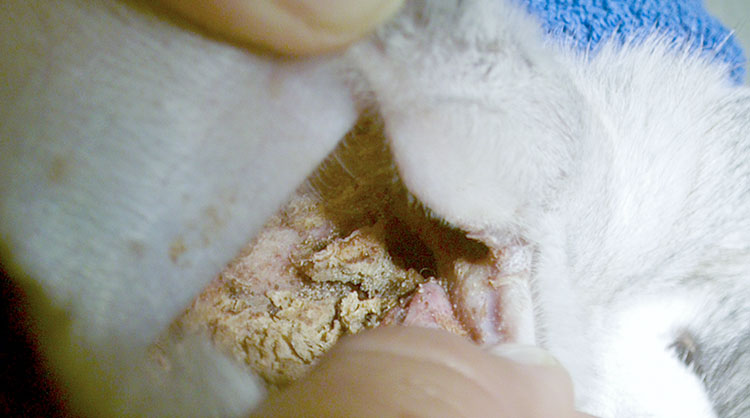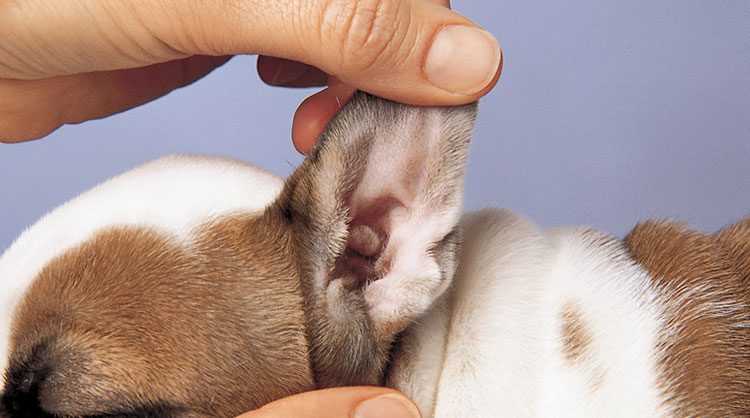How to Get Rid of Ear Mites in Dogs
Ear mites are a common external parasitic infestation known to plague dogs. Learn how to handle ear mites in dogs with our handy guide.
DOGS EAR MITES

Posted by bravectosouthafrica – 06 November 2019
What Are the Symptoms of Ear Mites in Dogs?
Ear mites – scientific name Otodectes cynotis – is a common parasite known to infect a variety of animals, including dogs. These tiny parasites are extremely contagious and can easily spread to other pets in your household. They transfer from one host to the next via close physical contact. Should your dog be suffering from an ear mite infestation, you need to seek treatment for the other pets in your household as well. This is necessary even if they haven’t displayed any symptoms yet. Cats are especially susceptible to ear mites, so be mindful of this.
Now, you might be wondering: can people become infected with ear mites? The good news is that human infections are exceptionally rare. Because the parasite that affects humans is different from the ear mites in dogs, humans will end up developing a skin rash if they become infected.
Ear mites will cause severe itchiness in your dog’s ears. If your dog is displaying any of the following symptoms or behaviour, they may be suffering from ear mites:
- Frequent head shaking
- Scratching at the ears
- Red, inflamed ears
- Excessive wax production
- Dry black discharge (which often resembles coffee grounds)
- Presence of a strange smell

If your precious pooch is displaying any of these symptoms or behaviours, be sure to schedule an appointment with your veterinarian. Ear irritation can have a multitude of causes outside of ear mites, including yeast or bacterial ear infections, and allergies.
Assuming your pup is suffering from ear mites can lead you to administer weeks of ineffective treatments. This will only prolong your dog’s suffering and irritation. It may even worsen the problem.
Your vet will use a special device, called an otoscope, to inspect the inside of your dog’s ears, since ear mites are nearly impossible to see without magnification. A diagnosis can also be made by collecting skin samples for laboratory testing or by taking a swab of your dog’s ear. Your vet will place the swab in mineral oil and have a closer look under a microscope.
No matter what course of action your vet takes, it is important to get an accurate diagnosis so that the correct treatment can start as soon as possible. Avoiding lasting ear damage should be a top priority.
It is possible to make an initial diagnosis at home. Gently remove a piece of debris from your dog’s outer ear canal and place it on a dark surface. Ear mites will be visible as tiny, pinhead-sized white specs moving about. Use a magnifying glass for a better look. You shouldn’t rule ear mites out as a possible cause, even if you were unable to identify any ear mites from the sample. The sample you used may simply have been ear mite-free.
Puppies and Ear Mites
Because of ear mites’ infectious nature, puppies can easily contract it from their parents. Ear mites can lead to middle and inner ear infections when the infestation is left untreated. This can, in turn, affect balance and cause permanent hearing damage.
Typical tell-tale indications of ear mites in puppies include:
- Head shaking
- Pawing and scratching at their ears
- Rubbing their head against the floor and furniture
- Whining
This behaviour can lead to further, more severe health issues.
Your puppy may bruise their pinnae (the external part of the ear). Floppy-eared dog breeds, such as bassets and beagles, may even develop a haematoma – a blood blister that forms because of trauma to the pinna. A puppy’s ears can become so sensitive that they won’t allow a vet to inspect them. If this is the case, your vet will have to sedate your puppy before treatment. Your vet will usually prescribe a follow-up treatment for you to continue with at home.

What Are the Different Vet Treatments for Ear Mites?
Your vet will recommend the best course of action for treating ear mites in dogs. Bravecto®, either the Chew or the Spot-On for Dogs, are popular and effective choices against various external parasites, including ticks, fleas and mites.
Stronger topical treatments are also available, which will need to be used for around 10-14 days. Thankfully, topical treatments can kill mites in all stages of their lifecycle. These treatments also include medication that will treat any underlying infections caused by the mites.
Ask your vet about using Bravecto® in the treatment of ear mites in your dog. Not only is it tried and tested, but it also boasts long-lasting effects.
Are There Oral Medications Available for Treating Ear Mites in Dogs?
Indeed there is! Introducing: Bravecto® Chew.
Bravecto® makes the treatment of ticks, fleas and mites quick and easy. The effects are also long-lasting – dogs enjoy 12 weeks of protection, all from a single dose. Your canine pal won’t even resist, as Bravecto® Chew is presented in a delicious treat form that they will want to gobble up immediately.
Even more good news: Bravecto® Chew for Dogs is approved for use in pregnant, lactating and breeding dogs. Invest in peace of mind by choosing Bravecto® for your four-legged friend.
Ask your vet if Bravecto® Chew is the right choice for your dog today.

The Best, Most Comprehensive Ear Mite Treatment for Dogs
If you’re on the lookout for a fast-acting, long-lasting solution to get rid of ticks, fleas and mites on your dog, look no further than Bravecto®. Not only does it treat any existing tick, flea and mite infestations, but it can also be applied as a preventative measure against these pests.
Bravecto® for Dogs is available in two variants: Bravecto® Chew and Bravecto® Spot-On for Dogs. Administering the treatment couldn’t be any easier. A single dose of Bravecto® Chew is given to your dog orally, with food. This chew will provide your pooch with 12 weeks of protection against ticks, fleas and mites.
Bravecto® Spot-On is applied by parting the hair at the back of your dog’s neck and dabbing the product directly onto their exposed skin with the convenient Twist’n’Use™ applicator. The Spot-On treatment will provide 4 months of protection against ticks and 6 months of protection against fleas. Protecting your pooch against external parasites is as easy as that! It also treats mites.
Afraid that you’ll forget to give your dog’s next dose on time? Never fear – Bravecto® has your back once again! Simply download the handy Bravecto® mobile reminder app. After creating a profile for your pet, set the date on which you last administered Bravecto® and the app will do the rest. Once the time to re-dose rolls around, you’ll receive a reminder, ensuring your dog remains protected against ticks, fleas and mites.
Ask your vet about the Bravecto® range and its benefits today.

More on Mange and Mites
The Kennel Club defines mange as ‘the infestation of your dog’s skin by tiny mites that usually result in hair loss and itching’.
A variety of different mites exist, some leading to more serious health issues than others. Ear mites generally tend to cause slightly less acute problems than some other species. However, each variety of mite boasts their own range of awful ill effects, no matter how severe.
The most common mange mites found to affect dogs are:
- Demodectic mites
- Sarcoptic mites
- Harvest mites
- Ear mites
- Cheyletiella
Since each species of mite is unique, a different treatment may be given to combat each infestation. Never self-diagnose and treat your dog, always see a registered vet to get the correct, safe treatment required.
The Link Between Ear Canker in Dogs and Ear Mites
Canker of the ears – also known as outer ear inflammation or otitis externa – is a painful condition that can affect all dogs. Depending on the breed and conformation of your dog, they may be more prone to suffering from this condition.
If your pup has long, floppy ears and narrow ear canals they are more likely to become afflicted. Their chance of developing this problem is increased even further, should they have hairy ear canals, as it affects the humidity and temperature inside the ear.
Anything that causes moisture to build up in the ear increases a dog’s chance of developing ear canker. Dogs who love swimming or licking each other’s ears beware! An excess of wax build-up in the ears, that isn’t cleaned regularly, can also lead to ear canker.
Should your dog be diagnosed with ear canker, there is a high chance that ear mites will also be present inside their ears. This further aggravates the already painful condition.
Should you suspect your canine companion is suffering from ear canker, schedule an appointment with your vet immediately. Help relieve their pain as soon as possible.
Getting Rid of Ear Mites in Your Home
If your dog receives an ear mite diagnosis, you’ll want to thoroughly clean your home. Ear mites can survive between 4-6 days away from a host. Because they are so hard to detect, some could be hiding in your carpets or on your couch.
Everywhere that your pet sheds, becomes a possible hideaway for these tiny pests. If you don’t take the time to properly clean your house, the chances of a re-infestation increase dramatically.
To ensure your house is completely free of any lingering ear mites, you’ll need to:
- Wash all your pets’ bedding on the hottest cycle (regular detergent will do the job).
- Do a thorough job of vacuuming any carpets and rugs throughout your house.
- After vacuuming, be sure to sprinkle some flea killing powder (it works for various external parasites) over your carpets and rugs. Make sure you get one that is pet and child safe. Allow the powder to sit for the specified time.
- Now, vacuum all carpets and rugs again.
- Repeat the entire process in two weeks.
Remember to groom or have all your household pets groomed to further ensure that all lingering mites are taken care of. Be sure to treat your dog and cat with Bravecto® afterwards. For long-lasting, fast-acting and safe tick, flea and mite protection, choose Bravecto®.

Learn more about Bravecto® products or find a stockist near you and protect your pets today!
Subscribe to our Newsletter
Get to know your furry friend better! Sign up for all things dog- or cat-related.
The Hairy Facts about the dreaded hairball
12 April 2021
Help! My dog’s barking mad! Volume 2
12 April 2021
Your Itchy, Scratchy Cat – All About Cat Skin Problems
12 April 2021
The Dog’s Diet: A Bone of contention?
01 April 2021
Mango Fly Worms: How to Spot and Eliminate them
Posted on November 28,2019
Managing Mange And Mites In Your Dog
Posted on June 11,2018
Why Do Cats Purr and How? Learn What Your Cat Is Saying
Posted on October 14,2020
How to Get Rid of Ear Mites in Dogs
Posted on November 06,2019









